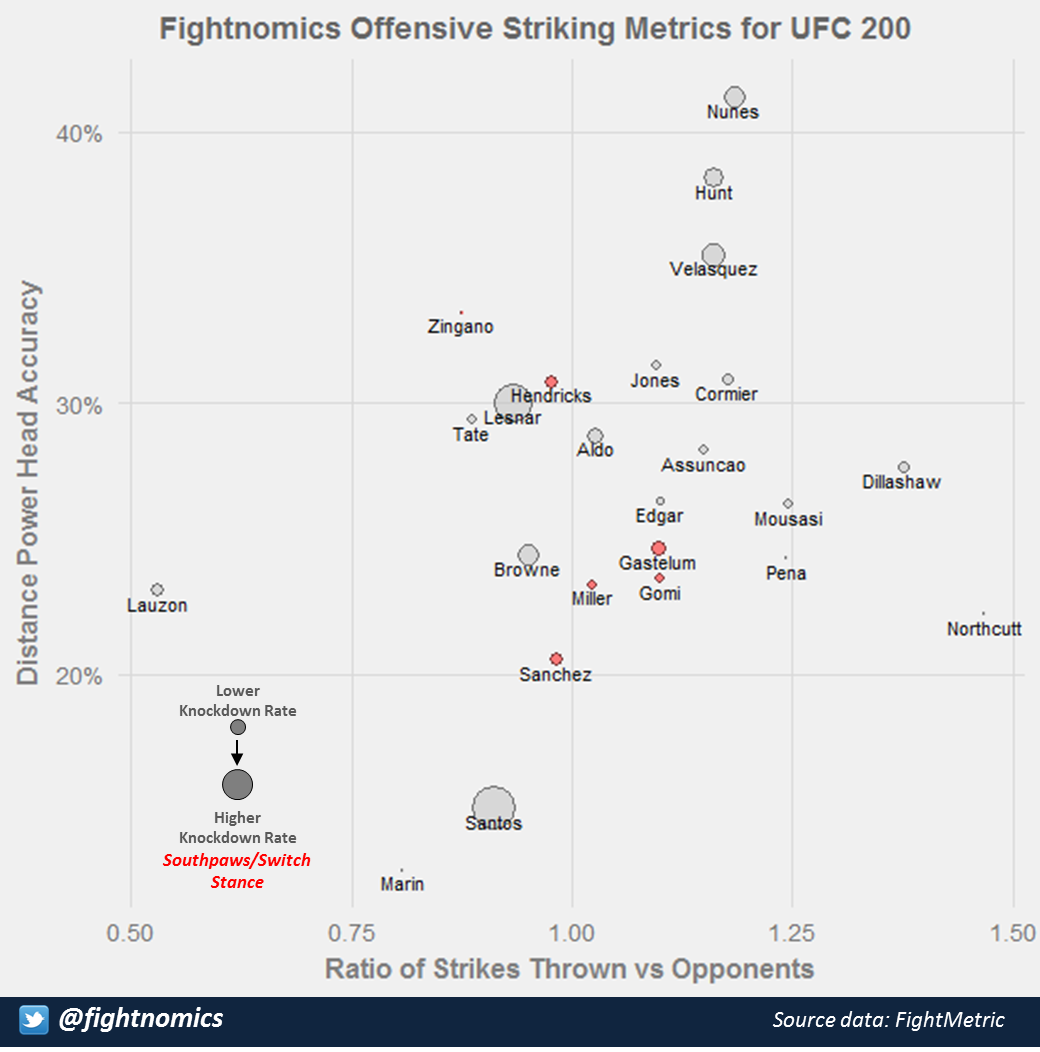By @fightnomics It’s an historic event years in the making, with three titles on the line and even the return of one of the biggest Pay-Per-View kings of MMA history. And thanks to such a stacked lineup, we have plenty of data on these fighters to explore. So let’s take a closer look at offensive striking metrics, and see which fighters excel in their standup game, and specifically how. How the Graph Works This balloon (or bubble) chart includes the fighters competing this weekend with sufficient sample size. Many of them will move with more cage-time, but it’s a good snapshot of how they’ve performed to date. The four metrics in the graph are all related to offensive striking. First, the vertical axis is the power head striking accuracy. This is a general reflection of a striker’s skill level in technique. But some fighters are more aggressive than others, while some are primarily counter-strikers, and those characteristics lead to very different striking styles. So the horizontal axis indicates the ratio of strike attempts while standing compared to the same fighter’s opponents. It’s a measure of output, and a proxy for aggression. An even 1.0 ratio means a fighter matches the pace of their opponents when standing and trading, while a higher number shows more aggressive and higher-volume strikers compared to lower ratios indicating counter-strikers. The dots are plotted based on those two metrics, but two more variables are also shown. The size of the bubble is based on the fighter’s Knockdown Rate in the UFC/Strikeforce/WEC. Bigger bubbles mean a lot more power, while the small specks indicate fighters who haven’t logged a knockdown in recorded competition. And lastly, southpaw/switch stance strikers are in red. Lefties are rare, but are worth highlighting as some fighters have trouble with Southpaws.
For more on these and other MMA performance metrics, get the book “Fightnomics.”
Snipers Women’s Bantamweight challenger Amanda Nunes has demonstrated a crisp accuracy rate of 41%, higher than any fighter on the card. That bodes well for the underdog challenger, because Tate’s standup striking defense has been poor to date. This suggests Tate’s game plan will be wrestling-centric, otherwise she’ll be at risk against Nunes’s strikes. Heavyweights Mark Hunt and Cain Velasquez have both done will with their hands, and each will be looking for a standing KO against their opponents Brock Lesnar and Travis Browne, respectively. High-Pressure Strikers Just three fights into his UFC career, young gun Sage Northcutt has shown a propensity for aggressive striking, outworking his opponents by 47% while on the feet. And that pairs well against Enrique Marin, who was somewhat hesitant and ineffective while standing in his UFC debut. Among fighters with more sample size, TJ Dillashaw’s evolved striking has been truly impressive, and while maintaining good accuracy he manages to outwork opponents by 38% on volume. Sluggers Replacement Thiago Santos boasts the best Knockdown Rate on the card at a whopping 29% on five knockdowns scored to date. That’s higher than even Brock Lesnar, who has scored two knockdowns on just nine landed power head strikes, for a rate of 22%. Among the veterans, Mark Hunt and Cain Velasquez also bring higher than average power into the cage, meaning both the heavyweight matchups for UFC 200 may be over quickly. Keeping it on the Ground Joe Lauzon has more Submission of the Night honors than anyone in UFC history at six, and more finishes at 11 than anyone in the Lightweight division. Clearly he knows how to end fights on the ground, which is perhaps why we see a very low rate of striking while on the feet. For information on getting the “Fightnomics” the book, go here.

